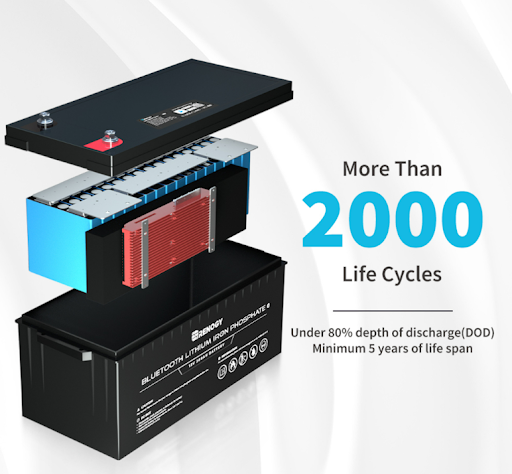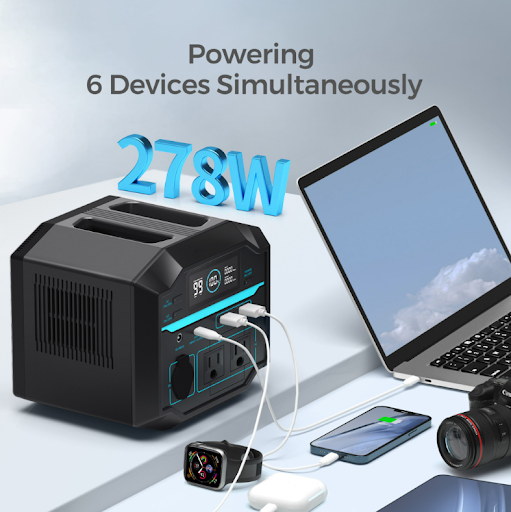Every solar generator includes the following basic components:
- Solar panels that convert sunlight into electricity
- A battery to store energy
- A charge controller that controls the flow of current to the battery
- An inverter that converts the power from the battery into the type of power required to run household appliances.
What is a watt?
A watt is a unit of measurement for electrical power. You need to know that every electrical device you own uses watts, and all devices have a specific wattage. If you add up all the wattage, you should be able to run all the devices on a normal day. So you already know the total wattage you need to generate on a typical day. An average single family home requires 6000 W or 6 kW (kilowatts) per day to function. A campsite, on the other hand, may only need 60 W.
Why should you invest in a portable solar power generator?
Purchasing a portable solar powered generator makes sense for a number of reasons, one of which is environmental friendliness. Below are the reasons:
- Portable solar power generators are easy to use. You flip the switch to turn it on and you’re good to go.
- A solar generator does not contain hazardous materials such as B. combustible fuels or cables that could cause fires. Also, they feature BMS technology that prevents over-voltage, short-circuit, over-heating and over-discharge.
- A solar power generator, like a photovoltaic system, does not produce any noise and is so quiet that you sleep while it is in operation
- be able.
- They emit no smoke or odor, so you can use them indoors with confidence.
- Because solar generators are compact and lightweight, they can be taken anywhere, including for camping and outdoor parties.
What is the best insolation for solar generators?
The panel element of your system needs maximum sun exposure to be successful. This is often an angle of 300 degrees between 10 a.m. and 4 p.m. At high latitudes, however, this insolation is not possible in winter, and in summer the sun is more directly overhead, reducing the angle.
If you live in an area with little sun exposure, the panels will still work, but they won’t generate as much electricity. If a solar generator says it can fully charge a battery in three hours, this is happening under ideal conditions. If you are using the system in an area with a lot of dense fog or foggy weather, you should lower your expectations.
Also think about where you want to set up the modules. In the heat, shady trees will not increase your performance. If the distance between the panels and the battery is too far, there will be some charge loss, but it is small compared to occluded sunlight.
Are solar power generators only suitable for emergencies?
Solar generators are increasingly used in various typical applications, from remote, off-grid locations to mobile applications. The benefit is mobility, as the solar generator system can be moved from one site to another as needed. They are well suited for communications towers, fire lookout towers, motorized access gates and open water systems such as illuminated sea buoys.
Such a device should definitely be in your emergency kit, especially if you live in an area where power outages due to natural disasters or unstable power grids are commonplace. When you don’t have to rely on the circling electric meter or a noisy and fuel-dependent gas generator, you can rest assured that you’re safe and secure.
Why are solar power generators better than gas powered ones?
Gas powered systems rely on fuel to function. When a hurricane sweeps through your location and there is no gas supply, you can only work as long as you can fill your generator’s tank. They make a lot of noise, emit toxic gases and consume a lot of natural resources.
Solar generators are renewable energy sources that can run for years with little or no maintenance other than cleaning the solar panels. Once you’ve invested in your system, you’re done, with no additional payments or hassles. They can be operated both in the sun and on cloudy days.
How much energy can a solar generator generate?
The solar panels and batteries are the limiting components of a solar generator system. Larger solar panels produce more energy. So the larger the plant, the more energy it can generate. Solar panel technology has improved to such an extent that even very small systems can generate large amounts of electricity.
The charge controller is programmed to match the amount of current coming in to the capacity of your battery(ies). If the amount of power supplied by the modules exceeds the capacity of your single battery, you can add additional batteries and store even more. Installing more batteries and panels than you need on sunny days can be a useful technique to tide you over the cloudy periods when your insolation fluctuates wildly.
A typical whole-home system consists of a roof full of panels, plus a large closet full of
12v lithium battery and other components to ensure everything works together. In certain circumstances, you may be able to connect to your local utility’s electricity grid and export excess electricity to the grid to help others and receive a credit instead of a bill. In this case, you become a mini utility company that has no problems running a utility company.

How much does solar power cost?
Fifty years ago, solar power was considered a luxury, and the cost for initial installation and ongoing renewal was about $100 per kilowatt. Today, solar power costs less than a dollar to generate the same amount of energy. This makes it cheaper every day for a wider range of consumers.
The price has fallen due to the higher efficiency of solar panel production and lower manufacturing costs. Many utility companies and local authorities offer buyers tax breaks or other incentives, further reducing the cost of a solar generator system. Financing alternatives are also being offered more and more frequently, which means that the initial investment is usually amortized within a few years or decades through lower operating costs.
If you still can’t afford a whole house system, you might want to try buying a smaller generator for specific applications such as: B. for pool filters (which are heated by solar panels), sump pumps (in case of emergency) or workshops or sheds. Today’s systems are durable and robust, ensuring your investment grows in value over time. That means you can have peace of mind even if a natural disaster or power outage doesn’t happen.
How to choose the best solar generator for your home or RV
Making the ideal choice takes more than just comparing prices and reviewing solar generators. Since everyone’s needs are different, it’s like comparing apples to oranges. The first step in choosing the best portable solar generator is to determine how much power you need to run essential equipment during a power outage. The solar calculator can help you calculate how many solar panels you need to install.
An average American household uses about 25,000 watts of electricity per day, or 1000 watts per hour. Most solar generators can produce 900 to 5,000 watts per hour, which means they can power everything from refrigerators to swimming pools. However, unlike gas powered generators, which can provide a constant power supply as long as the tank is full, solar generators cannot. They run on energy stored in batteries that need to be recharged between uses.
The key to choosing the best generator is determining how much power you need, what you can spend, and what characteristics are most important.
What to Look for When Buying the Best Portable Solar Generator
Whole-home solar systems with multiple roof-mounted panels and large battery storage can keep everything in the house running smoothly. First of all, the panels capture more energy. When some of the many LiFePO4 batteries are depleted, others are recharged, providing a continuous power source to power any home – albeit at a cost.
No portable generator can store enough electricity to power all of the appliances in your home. Portable solar generators, on the other hand, are inexpensive, easy to store, and can meet at least the most basic needs for on-the-go or emergency power needs.



















